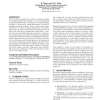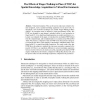83 search results - page 2 / 17 » Virtual Environments with Four or More Spatial Dimensions |
CCS
2011
ACM
12 years 5 months ago
2011
ACM
Cloud computing is quickly becoming the platform of choice for many web services. Virtualization is the key underlying technology enabling cloud providers to host services for a l...
AFRIGRAPH
2003
ACM
13 years 9 months ago
2003
ACM
Virtual sculpting enables the creation of computer models by emulating traditional sculpting. It can be implemented using spatial deformation, an interactive versatile modelling t...
ECTEL
2008
Springer
13 years 7 months ago
2008
Springer
Modeling the cognitive processes of learners is fundamental to build educational software that are autonomous and that can provide highly tailored assistance during learning [3]. F...
APGV
2006
ACM
13 years 9 months ago
2006
ACM
Distances in immersive virtual environments (VEs) have been commonly reported as being spatially compressed while the same judgments are performed accurately in real space. Previo...
SG
2010
Springer
13 years 3 months ago
2010
Springer
Abstract. Virtual environments (VEs) can be used to study issues related to human navigation, such as spatial knowledge acquisition. In our prior work, we introduced a new locomoti...


